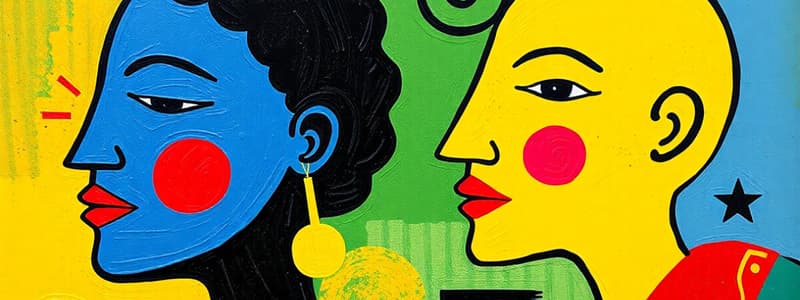Podcast
Questions and Answers
What term describes the observable elements of culture such as clothing and food?
What term describes the observable elements of culture such as clothing and food?
- Deep culture
- Core culture
- Surface culture (correct)
- Symbolic culture
Which aspect of culture requires a deeper understanding and includes beliefs and customs?
Which aspect of culture requires a deeper understanding and includes beliefs and customs?
- Visible culture
- Surface culture
- Deep culture (correct)
- Superficial culture
How is language essential to a society?
How is language essential to a society?
- It is mostly used for artistic expression.
- It solely reflects surface culture.
- It binds a culture into one through shared understanding. (correct)
- It creates boundaries between cultures.
What characterizes the changeability of surface culture compared to deep culture?
What characterizes the changeability of surface culture compared to deep culture?
Which of the following is an example of deep culture?
Which of the following is an example of deep culture?
What role do symbols play in a culture?
What role do symbols play in a culture?
What can be inferred about the evolution of language in relation to culture?
What can be inferred about the evolution of language in relation to culture?
What do human beings uniquely possess concerning language that other species do not?
What do human beings uniquely possess concerning language that other species do not?
What quality does the table's analysis need to reach the 'Excellent' criterion?
What quality does the table's analysis need to reach the 'Excellent' criterion?
Which level of completeness indicates that all components were present in the table?
Which level of completeness indicates that all components were present in the table?
What is indicated by a 'Fair' rating for accuracy in the analysis?
What is indicated by a 'Fair' rating for accuracy in the analysis?
Which aspect of the table does a 'Poor' rating for completeness reflect?
Which aspect of the table does a 'Poor' rating for completeness reflect?
What aspect is NOT considered when determining the 'Excellent' criterion of the analysis?
What aspect is NOT considered when determining the 'Excellent' criterion of the analysis?
What does slurping ramen soup in Japan signify?
What does slurping ramen soup in Japan signify?
Which action is primarily associated with informal norms?
Which action is primarily associated with informal norms?
What distinguishes mores from folkways?
What distinguishes mores from folkways?
What would a person be considered if they spit on the sidewalk?
What would a person be considered if they spit on the sidewalk?
How are values best described?
How are values best described?
What is an example of material culture?
What is an example of material culture?
What characterizes a subculture?
What characterizes a subculture?
What is a common cultural adaptation according to the content?
What is a common cultural adaptation according to the content?
What is an example of a formal norm?
What is an example of a formal norm?
Which of the following best describes mores?
Which of the following best describes mores?
What is a characteristic of informal norms?
What is a characteristic of informal norms?
Which action would likely be considered a violation of mores in a culture?
Which action would likely be considered a violation of mores in a culture?
How might outsiders interpret the Filipino gesture of pagmamano?
How might outsiders interpret the Filipino gesture of pagmamano?
What can be inferred about the symbolism of colors in clothing?
What can be inferred about the symbolism of colors in clothing?
What is the purpose of norms within a culture?
What is the purpose of norms within a culture?
Which of the following statements does NOT accurately represent laws as norms?
Which of the following statements does NOT accurately represent laws as norms?
What characterizes a subculture within a dominant culture?
What characterizes a subculture within a dominant culture?
How might subcultures develop their own unique understanding?
How might subcultures develop their own unique understanding?
What do ultraconservative groups typically do in relation to the dominant culture?
What do ultraconservative groups typically do in relation to the dominant culture?
Which of the following is an example of a group that embodies a subculture?
Which of the following is an example of a group that embodies a subculture?
How do subcultures interact within their own groups?
How do subcultures interact within their own groups?
What is an impact of subcultures on society at large?
What is an impact of subcultures on society at large?
In what way do fans of anime and manga represent a subculture?
In what way do fans of anime and manga represent a subculture?
What type of subculture could be described as supporting violent practices?
What type of subculture could be described as supporting violent practices?
Study Notes
Understanding Culture
- Culture is learned through observation, experience, and interaction with others.
- Surface culture is observable - things like clothing, language, and customs.
- Deep culture is less visible - composed of beliefs, values, and assumptions.
- Deep culture is often implicitly learned and can be difficult to change.
- Language is a vital part of culture, allowing for communication and shared understanding.
- Different cultures use language and symbols differently, creating varying interpretations.
- The evolution of language includes acronyms, variations in pronunciation, and slang.
Symbols in Culture
- Symbols hold special meaning within a culture.
- Pagmamano, a Filipino tradition, is an example of a cultural symbol.
- Symbols can be interpreted differently by outsiders.
- Emojis and emoticons are examples of symbols used in digital communication.
Norms and Values in Culture
- Norms are expected behaviors and rules within a culture.
- Formal norms are established by institutions and governments.
- Mores are norms based on morality, defining what's acceptable and unacceptable.
- Laws are codified rules backed by state power.
- Informal norms are customs that are socially accepted but not necessarily moral.
- Folkways are informal customs that are commonly practiced but not considered to be crucial for morality.
- Values are abstract ideas that guide judgments about what's good or bad within a culture.
Cultural Artifacts
- Objects and items that reflect a culture's norms and values.
- Examples of cultural artifacts: flags, traditional clothing, tools, and religious symbols.
- Artifacts carry significant meaning and symbolism within a culture.
Cultural Change and Adaptation
- Cultures change over time due to various factors like globalization, technology, and social movements.
- Societies adapt to new challenges and influences, leading to cultural evolution.
Subcultures
- Subcultures are smaller cultural groups within a larger dominant culture.
- Subcultures have unique interests, values, and ways of interacting.
- Examples of subcultures: teenager groups, sports fans, music lovers, online gaming communities.
- Subcultures often develop their own slang and symbols.
Countercultures
- Countercultures actively oppose certain aspects of the dominant culture.
- They may challenge prevailing norms and values.
- Examples of countercultures: extremist groups, anti-establishment movements.
- Countercultures are often driven by a desire to change societal practices or beliefs.
Studying That Suits You
Use AI to generate personalized quizzes and flashcards to suit your learning preferences.
Related Documents
Description
This quiz explores the concepts of culture, including its observable aspects and deeper meanings. It examines how language, symbols, and norms shape cultural understanding and communication. Test your knowledge about the intricacies of culture and the significance of symbols within it.




